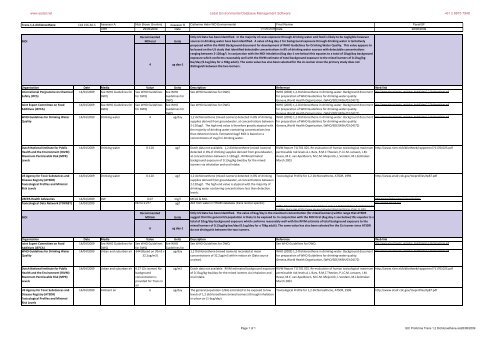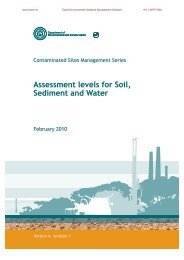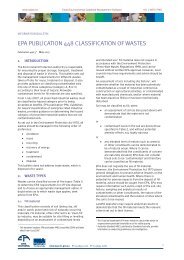Soil Generic Assessment Criteria for Human Health Risk ... - ESdat
Soil Generic Assessment Criteria for Human Health Risk ... - ESdat
Soil Generic Assessment Criteria for Human Health Risk ... - ESdat
Create successful ePaper yourself
Turn your PDF publications into a flip-book with our unique Google optimized e-Paper software.
www.esdat.net Esdat Environmental Database Management Software +61 2 8875 7948<br />
Trans-1,2-dichloroethene CAS 156-60-5 Assessor A: Nick Brown Grontmij Assessor B Catherine Helm WD Environmental Final Review Panel/SF<br />
Date 29/05/2009 Date 01/06/2009 Date 28/08/2009<br />
MDI<br />
Recommended<br />
MDIoral<br />
Units<br />
4 ug day-1<br />
Only US Data has been identified. In the majority of cases exposure through drinking water and food is likely to be negligible however<br />
sources in drinking water have been identified. A value of 4ug day-1 <strong>for</strong> background exposure through drinking water is tentatively<br />
proposed within the WHO Background document <strong>for</strong> development of WHO Guidelines <strong>for</strong> Drinking Water Quality. This value appears to<br />
be based on the US study that identified detectable concentrations in 8% of drinking water sources with detectable concentrations<br />
ranging between 2-120ug/l. In conjunction with the MDI Inhalation (6ug day-1 see below) this equates to a total of 10ug/day background<br />
exposure which con<strong>for</strong>ms reasonably well with the RIVM estimate of total background exposure to the mixed isomers of 0.13ug/kgbw/day<br />
(9.1ug/day <strong>for</strong> a 70kg adult). The same value has also been selected <strong>for</strong> the cis isomer since the primary study does not<br />
distinguish between the two isomers.<br />
Organisation Date Media Value Units Description Reference Web link<br />
International Porgramme on Chemical 14/04/2009 See WHO Guidelines <strong>for</strong> See WHO Guidelines<br />
See WHO Guidelines <strong>for</strong> DWQ<br />
http://www.who.int/water_sanitation_health/dwq/1,2-Dichloroethene.pdf<br />
Safety (IPCS)<br />
DWQ<br />
<strong>for</strong> DWQ<br />
Joint Expert Committee on Food<br />
Additives (JEFCA)<br />
WHO Guidelines <strong>for</strong> Drinking Water<br />
Quality<br />
14/04/2009 See WHO Guidelines <strong>for</strong><br />
DWQ<br />
See WHO Guidelines<br />
<strong>for</strong> DWQ<br />
See WHO<br />
Guidelines <strong>for</strong><br />
DWQ<br />
See WHO<br />
Guidelines <strong>for</strong><br />
See WHO Guidelines <strong>for</strong> DWQ<br />
DWQ<br />
14/04/2009 Drinking water 4 ug/day 1,2 dichloroethene (mixed isomers) detected in 8% of drinking<br />
supplies derived from groundwater, at concentrations between<br />
2-120ug/l. The high end value is there<strong>for</strong>e greatly atypical with<br />
the majority of drinking water containing concentrations less<br />
than detection levels. Estimated 4ug/l MDI is based on a<br />
concentration of 2ug/l in drinking water.<br />
WHO (2003) 1,2-Dichloroethene in drinking-water. Background document<br />
<strong>for</strong> preparation of WHO Guidelines <strong>for</strong> drinking-water quality.<br />
Geneva,World <strong>Health</strong> Organization, (WHO/SDE/WSH/03.04/72)<br />
WHO (2003) 1,2-Dichloroethene in drinking-water. Background document<br />
<strong>for</strong> preparation of WHO Guidelines <strong>for</strong> drinking-water quality.<br />
Geneva,World <strong>Health</strong> Organization, (WHO/SDE/WSH/03.04/72)<br />
WHO (2003) 1,2-Dichloroethene in drinking-water. Background document<br />
<strong>for</strong> preparation of WHO Guidelines <strong>for</strong> drinking-water quality.<br />
Geneva,World <strong>Health</strong> Organization, (WHO/SDE/WSH/03.04/72)<br />
http://www.who.int/water_sanitation_health/dwq/1,2-Dichloroethene.pdf<br />
http://www.who.int/water_sanitation_health/dwq/1,2-Dichloroethene.pdf<br />
Dutch National Institute <strong>for</strong> Public<br />
<strong>Health</strong> and the Environment (RIVM)<br />
Maximum Permissable <strong>Risk</strong> (MPR)<br />
Levels<br />
14/04/2009 Drinking water 0-120 ug/l Dutch data not available. 1,2 dichloroethene (mixed isomers)<br />
detected in 8% of drinking supplies derived from groundwater,<br />
at concentrations between 2-120ug/l.. RIVM estimated<br />
background exposure of 0.13ug/kg-bw/day <strong>for</strong> the mixed<br />
isomers via inhalation and oral intake.<br />
RIVM Report 711701 025. Re-evaluation of human toxicological maximum<br />
permissable risk levels A.J. Bars, R.M.C Theelan, P.J.C.M. Janssen, J.M.<br />
Hesse, M.E. van Apeldoorn, M.C.M. Meijerink, L.Verdam, M.J.Zeilmaker<br />
March 2001<br />
http://www.rivm.nl/bibliotheek/rapporten/711701025.pdf<br />
US Agency <strong>for</strong> Toxic Substances and<br />
Disease Registry (ATSDR)<br />
Toxicological Profiles and Minimal<br />
<strong>Risk</strong> Levels<br />
14/04/2009 Drinking water 0-120 ug/l 1,2 dichloroethene (mixed isomers) detected in 8% of drinking<br />
supplies derived from groundwater, at concentrations between<br />
2-120ug/l. The high end value is atypical with the majority of<br />
drinking water containing concentrations less than detection<br />
levels.<br />
Toxicological Profile <strong>for</strong> 1,2-Dichloroethene, ATSDR, 1996<br />
http://www.atsdr.cdc.gov/toxprofiles/tp87.pdf<br />
USEPA <strong>Health</strong> Advisories 14/04/2009 DW 0.07 mg/l MCLG & MCL www.epa.gov/waterscience/criteria/drinking/<br />
Toxicological Data Network (TOXNET) 14/04/2009 ND to 2,277 ug/l ADI from water in HSDB Database (trans isomer specific)<br />
http://toxnet.nlm.nih.gov/<br />
USEPA; National Contaminant Occurrence Database. trans-1,2-Dichloroethylene. Available from the<br />
Database Query page at http://www.epa.gov/safewater/data/ncod.html as of Apr 12, 2001.<br />
MDI<br />
Recommended<br />
MDIinh<br />
Units<br />
Only US Data has been identified. The value of 6ug/day is the maximum concentration (<strong>for</strong> mixed isomers) within range that ATSDR<br />
suggest that the general US population is likely to be exposed to. In conjunction with the MDI Oral (4ug day-1 see below) this equates to a<br />
total of 10ug/day background exposure which con<strong>for</strong>ms reasonably well with the RIVM estimate of total background exposure to the<br />
mixed isomers of 0.13ug/kg-bw/day (9.1ug/day <strong>for</strong> a 70kg adult). The same value has also been selected <strong>for</strong> the Cis isomer since ATSDR<br />
6 ug day-1<br />
do not distinguish between the two isomers.<br />
Organisation Date Media Value Units Description Reference Web link<br />
Joint Expert Committee on Food<br />
14/04/2009 See WHO Guidelines <strong>for</strong> See WHO Guidelines See WHO See WHO Guidelines <strong>for</strong> DWQ See WHO Guidelines <strong>for</strong> DWQ http://www.who.int/water_sanitation_health/dwq/1,2-Dichloroethene.pdf<br />
Additives (JEFCA)<br />
DWQ<br />
<strong>for</strong> DWQ<br />
Guidelines <strong>for</strong><br />
WHO Guidelines <strong>for</strong> Drinking Water<br />
Quality<br />
14/04/2009 Urban and suburban air 644 (Based on 20m3 x<br />
32.2ug/m3)<br />
ug/day<br />
http://www.who.int/water_sanitation_health/dwq/1,2-Dichloroethene.pdf<br />
1,2 Dichloroethene (mixed isomers) recorded at mean<br />
concentrations of 32.2ug/m3 within indoor air (Data source<br />
unclear).<br />
WHO (2003) 1,2-Dichloroethene in drinking-water. Background document<br />
<strong>for</strong> preparation of WHO Guidelines <strong>for</strong> drinking-water quality.<br />
Geneva,World <strong>Health</strong> Organization, (WHO/SDE/WSH/03.04/72)<br />
Dutch National Institute <strong>for</strong> Public<br />
<strong>Health</strong> and the Environment (RIVM)<br />
Maximum Permissable <strong>Risk</strong> (MPR)<br />
Levels<br />
US Agency <strong>for</strong> Toxic Substances and<br />
Disease Registry (ATSDR)<br />
Toxicological Profiles and Minimal<br />
<strong>Risk</strong> Levels<br />
14/04/2009 Urban and suburban air 0.27 (Cis isomer) No<br />
background<br />
concentration is<br />
provided <strong>for</strong> Trans in<br />
air<br />
ug/m3<br />
Dutch data not available. RIVM estimated background exposure<br />
of 0.13ug/kg-bw/day <strong>for</strong> the mixed isomers via inhalation and<br />
oral intake.<br />
14/04/2009 Ambient air 6 ug/day The general population (USA) estimated to be exposed to low<br />
levels of 1,2 dichloroethene (mixed isomers) through inhalation<br />
in urban air (1-6ug/day)<br />
RIVM Report 711701 025. Re-evaluation of human toxicological maximum<br />
permissable risk levels A.J. Bars, R.M.C Theelan, P.J.C.M. Janssen, J.M.<br />
Hesse, M.E. van Apeldoorn, M.C.M. Meijerink, L.Verdam, M.J.Zeilmaker<br />
March 2001<br />
Toxicological Profile <strong>for</strong> 1,2-Dichloroethene, ATSDR, 1996<br />
http://www.rivm.nl/bibliotheek/rapporten/711701025.pdf<br />
http://www.atsdr.cdc.gov/toxprofiles/tp87.pdf<br />
Page 1 of 1<br />
EIC Pro<strong>for</strong>ma Trans 1,2 Dichloroethene.xls28/08/2009








